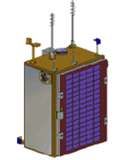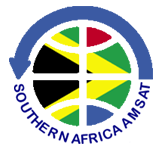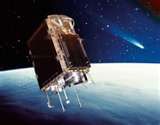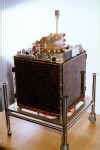A military institution designed to provide emergency communications has moved to new quarters in the Pentagon. On October 21, John G. Grimes, the former Assistant Secretary of Defense for Networks and Information Integration, cut the ribbon on the new Military Affiliate Radio System (MARS) station, now located on the fifth floor of the Pentagon. The facility -- manned by the Pentagon Amateur Radio Club (PARC) -- is packed with amateur radios, radio-telephone patches, computers and data links. "This is a great facility, manned totally by volunteers," Grimes told the crowd who came to see the new station. "It's a crucial capability for our country."
MARS, which began in the early 1950s, started as a worldwide network of shortwave radio enthusiasts who would spring into action in the event of a nuclear war or natural disaster. Thousands of civilian and military ham radio volunteers manned the system. With service members deployed far from home, or even overseas, MARS provided health and welfare messages called MARSgrams, allowing soldiers, sailors, airmen and Marines to keep in touch with their families back home. Today, those shortwave broadcasts have been superseded by the Internet; many service members use cell phones and Voice over Internet Protocol (VoIP) to speak with loved ones.
In the event of an emergency, high-frequency communication is generally the first to recover, and even the most modern technology can get overloaded. At the ribbon cutting ceremony, PARC member Allan Hubbert, KH6ILR, noted that there were communication problems during President Barack Obama's inauguration earlier this year: "During the inauguration, there were so many people on cell phones that it system was overloaded. We [hams] could still operate, and we helped back up the system down on the [National] Mall." More than 60 volunteers help to man the Pentagon MARS station.
With more than 6000 volunteers worldwide serving Army MARS, Air Force MARS and Navy-Marine Corps MARS, the system now backs up the Department of Homeland Security (DHS). "There have been many crises or disasters that have struck where the first word out of an area is via [Amateur Radio], and someone has their little gas generator going," Grimes said. "That's not likely to change any time soon." -- Thanks to the Department of Defense for some information


 The satellite was released from the rocket while over the Antarctic and accessed by the ground station at the Stellenbosch University ten minutes later when the first command was sent to 'wake up' the satellites. Despite the low elevation orbit of less than 10 degrees SumbandilaSat responded well with its first telemetry.
The satellite was released from the rocket while over the Antarctic and accessed by the ground station at the Stellenbosch University ten minutes later when the first command was sent to 'wake up' the satellites. Despite the low elevation orbit of less than 10 degrees SumbandilaSat responded well with its first telemetry. Earlier in September a team of SunSpace Engineers unpacked the satellite at the Baikonur launch facility in Kazakhstan and carried out a full systems test. All systems performed to specification. The amateur radio payload was tested from a little distance to check radio signal levels. All three systems performed flawlessly.
Earlier in September a team of SunSpace Engineers unpacked the satellite at the Baikonur launch facility in Kazakhstan and carried out a full systems test. All systems performed to specification. The amateur radio payload was tested from a little distance to check radio signal levels. All three systems performed flawlessly. SumbandilaSat is sponsored by the Department of Science and Technology and built at SunSpace in cooperation with the Stellenbosch University. In addition to the SA-AMSAT amateur module, the satellite carries Stellenbosch University's radiation experiment and software defined radio (SDR) project, an experiment from Nelson Mandela Metropolitan University and a VLF radio module from the University of KwaZulu-Natal.
SumbandilaSat is sponsored by the Department of Science and Technology and built at SunSpace in cooperation with the Stellenbosch University. In addition to the SA-AMSAT amateur module, the satellite carries Stellenbosch University's radiation experiment and software defined radio (SDR) project, an experiment from Nelson Mandela Metropolitan University and a VLF radio module from the University of KwaZulu-Natal. South Africa’s initial entry into the space age was in early 1999 with the launch of SunSat-1 (OSCAR-35), a modest satellite built by postgraduate engineering students at the University of Stellenbosch. The satellite carried various experiments and an amateur radio transponder that delighted ham radio enthusiasts world-wide. SunSat was operational for almost two years, until February 2001. (Source: AMSAT-S.Africa, ARRL.)
South Africa’s initial entry into the space age was in early 1999 with the launch of SunSat-1 (OSCAR-35), a modest satellite built by postgraduate engineering students at the University of Stellenbosch. The satellite carried various experiments and an amateur radio transponder that delighted ham radio enthusiasts world-wide. SunSat was operational for almost two years, until February 2001. (Source: AMSAT-S.Africa, ARRL.) 
 The FCC said there is no record that Roberts and PCR have ever received authority to operate this broadcast station. "Additionally, the 87.9 MHz frequency used by Roberts and PCR is not allocated to the FM broadcast band." The FCC noted that it has issued numerous warnings and Notices of Unlicensed Operation to Roberts and PCR detailing the potential penalties for operating an unlicensed radio station.
The FCC said there is no record that Roberts and PCR have ever received authority to operate this broadcast station. "Additionally, the 87.9 MHz frequency used by Roberts and PCR is not allocated to the FM broadcast band." The FCC noted that it has issued numerous warnings and Notices of Unlicensed Operation to Roberts and PCR detailing the potential penalties for operating an unlicensed radio station. On April 28, 2009, FCC agents, using radio direction-finding methods, traced a radio signal on 87.9 MHz to an antenna on the roof of a residence. Section 15.239 of the Rules provides that non-licensed broadcasting in the 88 to 108 MHz band is permitted only if the field strength of the transmission does not exceed 250 mV/m at three meters.
On April 28, 2009, FCC agents, using radio direction-finding methods, traced a radio signal on 87.9 MHz to an antenna on the roof of a residence. Section 15.239 of the Rules provides that non-licensed broadcasting in the 88 to 108 MHz band is permitted only if the field strength of the transmission does not exceed 250 mV/m at three meters. The following day, the agents observed Roberts operating PCR on 87.9 MHz from the Pirate Cat Cafe and Studio in San Francisco. The agents located the signal again radiating from same residence as the previous day.
The following day, the agents observed Roberts operating PCR on 87.9 MHz from the Pirate Cat Cafe and Studio in San Francisco. The agents located the signal again radiating from same residence as the previous day.

